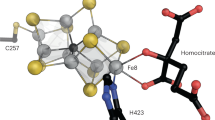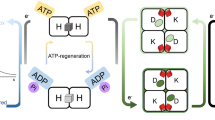Abstract
NITROGENASE from N2-fixing aerobes such as Azotobacter vinelandii is stable to air in crude extracts but on fractionation into its two protein components, Fe–Mo protein and Fe protein it manifests the O2 sensitivity characteristic of other nitrogenases1. This difference between the air-stable and air-labile forms of the enzyme has been ascribed to various causes2–4. More generally, the incompletely defined correlations between in vivo and in vitro nitrogenase function with respect to optimal component ratio5, local pH6, ATP stoichiometry7, reductant8, catalytic behaviour4,9 and other important enzymatic parameters are a source of ambiguity in biochemical studies on the cell-free enzyme. In principle, effects from changes in many of these parameters can be studied by parallel in vivo and in vitro substrate reduction and inhibition studies. In practice10, restrictive limitations are imposed by the paucity of nitrogenase substrates that are at once (1) well bound, (2) capable of diagnostically complex chemical interactions, and (3) compatible with function of the enzyme in living microorganisms. For example, among known substrates other than N2 itself, C2H2 is deficient in reduction complexity10, HCN is excluded by its cytotoxicity and acrylonitrile, which displays interesting product patterns11, is a poor substrate12. Recently, cyclopropene was shown to undergo ATP-dependent nitrogenase-catalysed reduction to propene and cyclopropane in vitro13. The product ratio of ∼2:1 alkene:cycloalkane was found to be insensitive to purification over a specific activity range of 40–1,200 in conventional assay conditions. We report here results of further nitrogenase-cyclopropene investigations which establish that: (1) nitrogenase in living A. vinelandii catalyses cyclopropene reduction to the products observed in vitro in the same ∼2:1 ratio; the Km for formation of either product is very similar if not identical to that obtained with cell-free enzyme; (2) with purified components (specific activity up to 2,000) at optimal stoichiometry, the Km for formation of the reduction products (propene and cyclopropane) is 0.01 atm, corresponding to a molar Km as low as that of N2 (and C2H2). These findings strengthen the case for catalytic similarity between in vivo and in vitro nitrogenase. Conversely, they substantiate the importance of cyclopropene product ratio as a chemical probe for the enzyme and as an important new criterion for nitrogenase biomimetic chemistry.
This is a preview of subscription content, access via your institution
Access options
Subscribe to this journal
Receive 51 print issues and online access
$199.00 per year
only $3.90 per issue
Buy this article
- Purchase on Springer Link
- Instant access to full article PDF
Prices may be subject to local taxes which are calculated during checkout
Similar content being viewed by others
References
Winter, H. C. & Burris, R. H. A. Rev. Biochem. 45, 209–426 (1976).
Scherings, G., Haaker, H. & Veeger, C. Eur. J. Biochem. 77, 621–630 (1977).
Haaker, H. & Veeger, C. Eur. J. Biochem. 77, 1–10 (1977).
Burns, R. C. & Hardy, R. W. F. in Molecular Biology, Biochemistry and Biophysics Vol. 21 (eds Kleinzeller, A., Springer, G. F. & Wittman, H. G.) (Springer, New York, 1975).
Shah, V. K., Davis, L. C. & Brill, W. J. Biochim. biophys. Acta 384, 353–359 (1975).
Orme-Johnson, W. H. et al. in Recent Developments in Nitrogen Fixation (eds Newton, W., Postgate, J. R. & Rodriguez-Barrueco, C.) 131–178 (Academic, New York, 1977).
Watt, G. D., Bulen, W. A., Burns, A. & LaMont Hadfield, K. Biochemistry 14, 4266–4272 (1975).
Hageman, R. V. & Burris, R. H. Biochemistry 17, 4117–4124 (1978).
McKenna in Molybdenum and Molybdenzymes (ed. Coughlin, M. P.) Ch. 14 (Pergamon, Oxford, in the press).
McKenna, C. E. et al. in Nitrogen Fixation, Vol. 1 (eds Newton, W. E. & Orme-Johnson, W. H.), University Park Press, Baltimore (in the press).
Fuchsman, W. H. & Hardy, R. W. F. Bioinorg. Chem. 1, 195–213 (1972).
Hardy, R. W. F. & Jackson, E. K. Fedn Proc. 26, 725 (1967).
McKenna, C. E., McKenna, M-C. & Higa, M. T. J. Am. chem. Soc. 98, 4657–4659 (1976).
Benemann, J. R., McKenna, C. E., Lie, R., Traylor, T. G. & Kamen, M. D. Biochim. biophys. Acta 264, 25–38 (1972).
McKenna, C. E. et al. in Proceedings of the International Symposium on Molybdenum Chemistry of Biological Significance (eds Otsulca, S. & Newton, W. E.) (in the press).
Drozd, J. & Posgate, J. R. J. gen. Microbiol. 60, 427–429 (1970).
Wilhelm, E. et al. Chem. Rev. 77, 219–262 (1977).
McKenna, C. E., McKenna, M-C. & Huang, C. W. PNAS (in the press).
McKenna, C. E., Jones, J. B., Eran, H. & Huang, C. W. Nature 280, 611–612 (1979).
McKenna, C. E., Nakajima, T., McKenna, M-C., & Newton, W. E. (in preparation).
Smith, L. A., Hill, S. & Yates, M. G. Nature 262, 209–210 (1976).
Author information
Authors and Affiliations
Rights and permissions
About this article
Cite this article
MCKENNA, C., HUANG, C. In vivo reduction of cyclopropane by Azotobacter vinelandii nitrogenase. Nature 280, 609–611 (1979). https://doi.org/10.1038/280609a0
Received:
Accepted:
Published:
Issue Date:
DOI: https://doi.org/10.1038/280609a0
This article is cited by
Comments
By submitting a comment you agree to abide by our Terms and Community Guidelines. If you find something abusive or that does not comply with our terms or guidelines please flag it as inappropriate.



